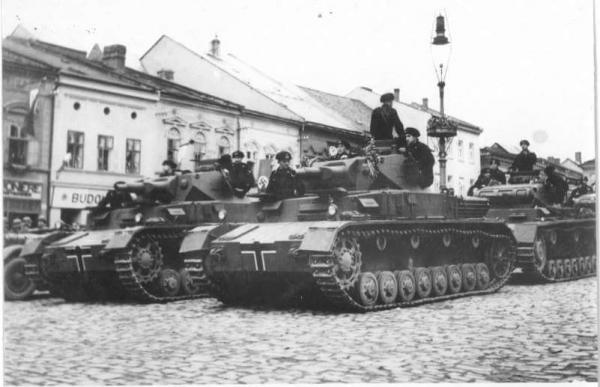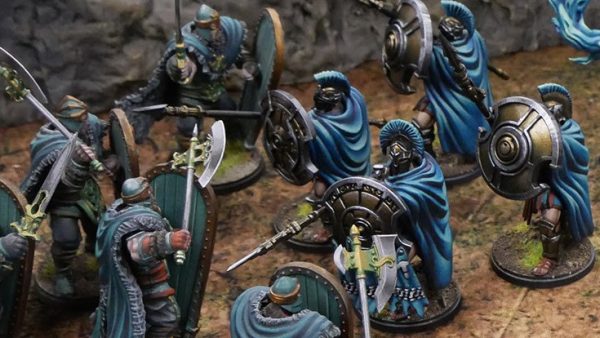Home › Forums › Historical Tabletop Game Discussions › Poland 1939 – Preparing for 80th Anniversary of World War II
Tagged: historical, Oriskany, Poland, World War II, Yavasa
- This topic has 121 replies, 12 voices, and was last updated 6 years, 2 months ago by
jamesevans140.
-
AuthorPosts
-
September 5, 2019 at 2:53 pm #1432653

Part One of the latest Poland Wargame between myself and @yavasa is now up on the Sitrep Podcast YouTube Channel. 😀
“Oriskany” and “Yavasa” continue their 80th Anniversary Commemorative Panzer Leader Series of the Polish Campaign of 1939. This time we’re recreating part of the Battle of Jordanów, where 2nd Panzer Division tangled with the 10th Motorized Cavalry Brigade in one of the first mobile engagements of World War II, fought primarily on 2 September, 1939, opening the southern invasion routes toward Kraków.
September 5, 2019 at 5:25 pm #1432705Thanks @torros I would be interested if you find it. I have a 15mm armoured train I use in my Winter War games. It is a Russian train however Russian, Finnish and Polish armoured trains look quite similar.
September 5, 2019 at 5:28 pm #1432706Great to see you back on line @oriskany, I hope you did not sustain too much damage from the hurricane. Off to watch the new post.
September 5, 2019 at 6:38 pm #1432725I look forward to part two @oriskany
Recon in the defence. Often used to screen you flanks and can be deployed forward of your main line of resistance. In this rule recon has two missions.
- To see off the enemy recon units preventing them from observing you main line of resistance.
- To break up the enemy attack. Forcing the enemy to go from transport column formation to deploying for battle far earlier than he would prefer. In this game it was well executed forcing you out of your trucks sooner than you would like. Normally the forward recon units would be supported by medium range artillery to smash the now slow moving infantry. Normally the forward recon units would then fall back behind units just forward of your main line of resistance and do it all over again. While suicidal it was extremely aggressive to go on to the attack rather than withdrawing to the next defensive position.
It will be interesting to see if there will be a price to pay for being that aggressive rather than withdrawing to slow you down again.
For the guys who don’t want to remark their German tanks there is a way around this. As you said the white or yellow crosses proved too good of an aiming point, so after only a few days the panzer crews started blotting them out completely by covering them with mud.
Even though there were very few PZ-3s and PZ-4s they tended to make a big difference wherever they were used. The PZ-1s and PZ-2s were comparable to the Polish TK tanks including the ones modified to carry a 2 cm gun. The big difference was the Germans deployed them so the Polish armour was heavily outnumbered and the German radio net gave them a clearer picture of the battle space allowing them to quickly out maneuver anything the Poles attempted.
What I personally like about the Polish Campaign is that it was mostly fought by armoured vehicles armed with mostly MGs and 2 cm guns. You can have your Sdkfz 221 and 222 mix it up with the Polish TK tanks in quite even terms. Anywhere else and the Sd recon vehicles would be useless and easily brushed aside. Poland offers the wargamer when the scenario is balanced two fairly evenly matched sides. It is much harder to achieve this in later campaigns.
September 5, 2019 at 6:44 pm #1432726@jamesevans140 Ah, yes the Wajda movie. He actually defended himself by saying that this was to show the heroism and at the same time the situation that Poland was in in 1939. It’s a good movie but yes, it did add to the myth by using it for a different purpose.
I do agree that Poland was not ready for the new type of war that happened in 1939. There were people like later General Stanisław Maczek (known later for closing the pocket at Falais, a brilliant tank commander) who were thinking outside the box. Actually, the game that @oriskany posted, the Battle of Jordanów, saw his 10th Motorized Brigade doing some serious defensive work. If it wasn’t for the situation on other parts of the front he would stop the the German advance for a longer period of time. Sadly there weren’t many people thinking like him before 1939 and even if they were there was not enough money to reequip the troops with better equipment. At Mokra we saw what a well trained and equipped cavalry brigade coul do to a German Panzer Division. However, as you say, the German doctrine, radio communication and air support and mobility made them always one step ahead.
@oriskany thanks for posting the game and glad to see you back.
September 5, 2019 at 8:32 pm #1432753
All right, everyone. Finally catching up after what has been a very interesting week.
I’ll say this much. Having a Category 5+ hurricane barrel straight toward you, then halt just short of you, pause, and finally turn away … in effect put your life on hold for a week but never actually hit you directly … really forces you to take a calming break to step back and reassess.
I’ve been in 20 named tropical cyclones, 12 of them full-on hurricanes, the shit is never fun. You never get used to it.
Okay, on to replies (starting from quite a ways back)
@jamesevans140 – Yeah, with respect, we’re going to continue to disagree on calling PzKpfw IIs and Is “tankettes.” Our own definitions and what we “consider” are not the issue, there are established and formal military and industrial definitions for these terms that apply. Now some variants of the PzKpfw I later in the war are sometimes dropped under this classification (i.e., Panzerbefehlswagen I), but even these are usually disputed. Command tanks and training tanks are not tankettes.
Where I do agree 100% is the top-down reorganization we see with the Wehrmacht between Poland and the campaigns of the west in 1940. From the operational changes to the division, the strategic changes in how many divisions there would be, to the start of the gradual sunset of the “light division” concept (there’s a ways to go on that one), to the tactical changes in the squad you mention all the way to the color of the crosses painted on German tanks … The Germans learned a lot here and would apply these lessons later in the war (as I’m sure you would agree).
Yes, @yavasa and I wanted to do more battles. Even when we ran battles we didn’t record (like this latest Battle of Jordanów) I wanted to find a way to put it up besides the usual barrage of slides and text no one reads.
I think you are allowed a few oversights here. – Not really sure what this means. Yourself and @yavasa and others keeping the thread going while we rode out the storm? If so, yes. I agree and appreciate it immensely.
@yavasa – yes, the Ops Center went up last Saturday for Patreon supporters and later in the day for general public on the Sitrep Podcast Channel. I’m not sure why it didn’t go up on OTT or Podbean on schedule. Last episode was also late on Podbean. I’m not really in charge of that side of it.
Cavalry vs. Tanks: Before we dismiss this, there are a few ways to slice this, correct? Just because Polish cavalry never charged German tanks doesn’t mean Polish cavalry was never used against German armor. From what I remember, and I confess I could totally be wrong about this, I think a German panzer aufklärungsabteilung (armored cars like the Kfz 13 and SdKfz 221) became isolated from the division’s main body and were attacked out of a wood by Polish cavalry … who may have fought that engagement dismounted (Battle of Krojanty – sorry if you guys have already talked about this in detail).
This is how myths get started, though. People hear “cavalry” and “tanks” and before you know it we have the image of saber-swinging lunatics galloping down the barrels of German 88s. This is why terms are so important.
I am not familiar with the movie you guys are talking about. But I’ve never been a fan of WW2 movies, given the overall balance of fact and fiction.
Battle of Mokra – Indeed this one was recommended by @torros and others. I was considering using it for a Panzer Leader game (I’ve always wanted to try out armored trains in Panzer Leader) but honestly I took one look at the battle area and balked at the map that would have to be drawn for that. As a major project, sure … but just part of an overall Poland campaign with @yavasa and I going online in less than an hour (at the time of building our latest game) – I just didn’t have time. The convergence of three rivers like that would make for an interesting battlefield in Panzer Leader one of these days, though. Speaking of river crossings, looks like we might be doing the Wall River in Market Garden soon (75th Anniversary coming up).
Again there is a myth about the German soldier being the best in the world. – Eh … agree 80%? We’re putting this our games, as you’ll see, not allowing the Germans to use the split move and fire rule, keeping them at the B or C level of Morale / Cohesion, etc. leaving aside a precious handful of SCW and WW1 veterans, the German Army here really are all “noobs.” Well trained noobs, probably better than almost anyone else, but noobs nonetheless.
I will stand by German training. Polish, British, Soviet, French, or American training are just not up to the same level. In even more objective terms … German infantry units are equipped with weapons like the MG34 at the squad level. Granatenwerfer 34 5.0cm mortars at the platoon and company levels. The 7.5 cm leichtes Infanteriegeschütz 18 at battalion level. Seriously, no one else has an infantry support package this complete in 1939.
So best trained soldiers? Certainly moreso than major combatants in 1939. And best equipped / best supported soldiers? Absolutely. But courage? Experience? Accepting that these are wholly subjective measures (if you’ll excuse the contradiction in terms), no, no better than potential or actual 1939 enemies.
September 5, 2019 at 8:54 pm #1432754And he’s back 😀
@oriskany got to agree with the lack of experience when it comes to German soldiers, same with Polish ones when specifically referring to the 1939 campaign. Have to agree even more on the equipment and especially it’s use.
You are right with the cavalry fighting armor part. It did happen. As I have posted earlier cavalry fought dismounted and it did face armor a lot in 1939 with Mokra and Krojanty being the most notable ones.
I am not sure what are you referring to with the “I think you are allowed a few oversights here.” Did I miss something? 😀
September 5, 2019 at 11:16 pm #1432784
Remainder of replies:
Reconnaissance in Defense: Often used to screen you[r] flanks and can be deployed forward of your main line of resistance. – Yes, that’s how I used it when deploying the Poles in this game.
To see off the enemy recon units preventing them from observing you main line of resistance. – Agree. Admittedly it didn’t happen here, because Polish reconnaissance units could not hope to match the mobility of their German counterparts. This is the kind of thing that’s difficult to capture in a miniature game because the tables are never large enough to encompass the true interrelationship between tactical distances and ranges of the units compared to their movement. Their “spheres of gravity” are always too big for a table too small. Here, German armored cars of Panzer Aufklärungsabteilung 5 (and even PzKpfw IIs of PzRgt 3) were just too fast. They could slip through gaps the Polish skirmish line (using that term loosely) and by the end of Turn 1 recon motorcycle detachments had eyes on the first Polish objective hex – by Turn 2 that hex was under fire.
To break up the enemy attack. Indeed. The video as published so far only covers to the end of Turn 1, but already we can see that happening with Polish cavalry out of Wysoka hitting the motorized vanguard of Schützen Rgt 2./2nd Panzer Division. They’ll be a lot more to come on that, but @yavasa might be able to speak more directly along those lines as he was in command by that point.
Normally the forward recon units would be supported by medium range artillery to smash the now slow moving infantry. – Not entirely sure I would agree, unless the recon units have their own integral artillery support (which hex, some do … German aufklärungsabteilung would usually have a battery of 7.5 cm IGs in their OOB). But conventional regimental or divisional artillery support, usually deployed in a second tactical echelon behind the main line of contact becomes problematic in my view. By the time enemy vanguard or recon units are in range of your artillery, they’re too close. Your main line of contact is probably in range of enemy artillery in turn, and the whole point of this exercise is to disrupt enemy approach vectors at a distance.
That said, I would agree that “defensive reconnaissance” can help vis-a-vis in the establishment of pre-sited fire plans and the like. And of course, if your artillery just has a range advantage over the enemy … you can probably get away with that.
In any event, this would be a theoretical case in Poland, as German artillery far outranged Polish artillery even in weapons of similar calibers and so far as I can tell, Polish artillery batteries were still set up on a direct fire “field gun” model, rather than indirect regimental or divisional fire support.
Normally the forward recon units would then fall back behind units just forward of your main line of resistance and do it all over again. Absolutely. This was the role of US armored cavalry in the classic “Fulda Gap” scenario in West Germany.
It will be interesting to see if there will be a price to pay for being that aggressive rather than withdrawing to slow you down again. – That would certainly be the plan, but spoilers … as we’ll see in Parts 2 and 3, it never happens here with the Poles on this particular battlefield. The differential between German and Polish mobility is just too great. And, in all fairness, the Germans are played by a 25-year veteran of the game who drew the map. To his credit, @yavasa does use his few 7TP and 7TP upgrades in a mobile defense role in the last three turns of the game. No spoilers on who actually wins this game, suffice it to say for now it comes very very close.
Not to say this would be the case on all Polish battlefields. Against a German infantry division, I’m sure this would work great. But here it doesn’t because you’re up against SdKfz 222s, 231s, and PzKpfw IIs. By the time your short range weapons can engage … yes, some of the enemy are already behind you.
Even though there were very few PZ-3s and PZ-4s they tended to make a big difference wherever they were used. Couldn’t agree more. 2nd Panzer Division was a premiere unit and even now our research shows only two platoons of PzKpfw IV (As and Ds mostly) – and no PzKpfw IIIs at all. Like my disclaimer says near the front the video, that was a “historical license” taken to provide a little “tank on tank” action in the game. The Poles were similarly “gifted” with a company of three platoons of 7TP upgrades (10th Motorized Cavalry Brigade had none of these at the time).
What I personally like about the Polish Campaign is that it was mostly fought by armoured vehicles armed with mostly MGs and 2 cm guns. I agree with the history of that statement, where it gets rough is from a gaming perspective. So many tank / armored car platoons that can’t realistically hurt each other (as @yavasa will attest) results in some strange battlefield dynamics (the armored car / tankette demolition derby we saw at the end of Game 02 – Tomaszów Lubelski). I normally enjoy early war games more than late war, because of the primacy of maneuver over raw firepower … but at some junctions here in Poland it’s almost started to feel like too much of a good thing.
You can have your Sdkfz 221 and 222 mix it up with the Polish TK tanks in quite even terms. – this is true, they just can’t overrun. Ranges are 2 hexes (300-500 meters), while movement rates are 6, 8, or 10. So … why fight? Overrun is the only viable game tactic here, and that’s not allowed because no “A” class weapons (autocannon are usually H or AA class). This might be more of a game mechanic corner case, though, easily resolved through a special scenario rule. (H class weapons can overrun assuming enemy DFs are 2 or less).
@yavasa – Yeah – I was sure you guys were talking cavalry vs. armor about this somewhere in the thread or in YouTube. So I mentioned with an addendum “as you guys probably said” so I wasn’t just repeating other people’s contributions. 😀 You’re definitely more knowledgeable on this campaign than I am.
“I think you are allowed a few oversights here.” – Back on Page 5 from @jamesevans140 . I don’t want to ignore it, but I don’t want to respond until I understand more of the context.
Poland 1939 – Preparing for 80th Anniversary of World War II
September 7, 2019 at 12:44 pm #1433268@oriskany Panzer Leader for me is one of these games that are easy to learn but hard to master 🙂 I think that there is a long road before me when it comes to learning stuff like defense with tanks and so on. I find it hard to maneuver with I and H class weapons tanks against A class weapons. You did push the spearhead forward with A class tanks in our last game and I found it hard as a newbie to find a way to tacke them game wise. Still I love the game and the options it allows the players. It does reward planning and pusnishes mistakes.
September 8, 2019 at 1:04 am #1433595Well, in all honesty @yavasa , I think part of what we’re dealing with here in Panzer Leader 1939 is a “culture shock” of just how underequipped especially the mechanized forces of both sides actually were … and the game coping with those conditions. Not that the game is broken, in fact quite the contrary, it is behaving perfectly. I think I’m just used to certain tactics working and turns out they don’t behave quite as we’re accustomed to because the game is so “underpowered” compared to later periods.
If you ever want to try Panzer Leader in a more conventional setting, give me a shout and we’ll set something up.
As it is, trying to learn Panzer Leader in 1939 is like learning to swim in a pool only two feet deep. 😀
September 8, 2019 at 11:28 am #1433656This may appeal to your sense of trivia…
Black in-filled crosses were not truly an invention of Poland, but a return to previous campaign markings as an expedient response to their use as aiming points…
From 1938;

Poland was largely an Infantry war, despite the glamour and glitz on Panzer units, it was hardly a ‘Blitzkrieg’ and was fought more like 1914 than 1940. It showed what was to come, but did not necessarily show it by example.
September 8, 2019 at 6:48 pm #1433800@piers – indeed, those white and yellow crosses seem to be a feature of the Poland Campaign only, I’ve never fully understood why. I’ve seen more “traditional” balkenkreuz” pre-war, and of course for the 1940 campaign forward (several types), but never again those yellow and white crosses, from what I’ve read they seemed to make too much of a good aiming point for enemy gunners.
Agree 100% on the non-mechanized preponderance of Poland 1939. The same could be said for most early or even mid-war campaigns. For our Panzer Leader campaign we are shamelessly cherry-picking, rooting through the campaign for the most mechanized engagements we can find and using those as a basis for the Panzer Leader scenarios. Hence engagements like the mechanized sections of battles like Borowa Góra, Tomaszów Lubelski, and Jordanów.
September 8, 2019 at 7:27 pm #1433819I think the white cross was to be a campaign only marking.
It was a very good aiming point, especially in poor light. Crews quickly dirtied them up, as US tankers did with Stars in Normandy at times.
Interestingly, Heimwehr Danzig used a hollow cross, very 1943/44, on the Polish vehicles they captured and used in 39.
September 9, 2019 at 4:40 am #1433925Yep @oriskany tankettes will remain a friendly point of total disagreement between us. We are both entrenched in our point of view and neither of us are going to give an inch. However if we agreed on everything it would be extremely boring and I would not be hanging around. Agreement does not equate to friendship, so I am happy for us to agree to disagree.
For future however it is pointless stating to me military terms as they are transient in specific meaning in times of charge and in Poland 39 warfare is in a state flux.
Take the term cavalry in 1938 in means you ride a horse. In 44 it describes a form and function of light AVFs or for the US cavalry it meant you ride a tank destroyer. Even today I have to use both the US and British dictionary of military terms for specifics as they use different meanings for the same word or the other way a around. Very broad definitions at least similar. Thankfully we can agree what infantry means.
Please don’t take this as an attack. I am just in all openness stating my position in as much clarity as possible. I am happy with your stance. I don’t thick your wrong I accept your opinion is different to mine.
What I stated about recon in defence was straight out of German doctrine of 1936 and as amended in 1938. The play book they took to Poland. Lacking true experience back in 1936 most units were assigned a role in the attack and a role in defense. However here the kicker. Those in power were firmly in the school of attack. You could use the defense role but if you stated you were on the defense you were considered to not suitable as a field officer. That is why you get silly terms from the Germans in later war such as advancing backwards. Yes I have read translated battlefield reports using this term.
For me Poland is Germany’s Kasserine but because they won they took less away from it than the Americans did. The Germans did take it as a wake up call to that they did not get everything right and changes were needed and to their credit most changes were in place by the time of France. What really shocked the Germans about the real Kasserine is the US had its lessons learned in place by the next major battle.
Your point about tank vs horses completely accepted in fact already implied. I opened the discussion with @yavasa stated my preferred Polish unit was the cavalry brigade as they were most suited to take on a German panzer or light division. While mentioning them the German light division was supported to be the modern version of traditional horse cavalry, however a number of the high command disagreed with it stating horses were still the only viable vehicle for the East.
Now back on topic. We were talking about the myth created by the propaganda. In the time of horse and musket in Europe the Polish Lancer was consider to be by far the best cavalry in the world. In typical Nazi fashion they mocked this and tried to say look at how stupid they are, they have not learned a thing since and don’t have the right to be in a modern world. This pay back if you like stems from the fact that Germany got a good sleep across the face given them by the Poles in the boarder wars back in the 1920’s. This is another topic rarely talked about today.
Even before WW1 the Australian Light Horse had relegated the lance to a ceremonial parade ground device just like the officers sword is today. At country carnivals today the skill is still alive today and was used for some time to impress the mums and dads that their defence were in good hands. Most movies made up to the late 50’s if they showed the Australian Light Horse have them carrying the lance. Coming from a Light Horse family it annoys me to no end setting it. Yet in the Australian film 40,000 Horse
Men, the title is a play on 40,000 thieves, there they are carrying lance. The issue is the story teller relies heavily on public perception rather than fact. It saves them pages of descriptions. They also use devices that go all the way back to Greek humor and tragedy. One such device is the tragic or doomed hero excepting his fate and going valiantly to their doom none- the- less. In the Polish film the director used the lance charging tanks as a tragic hero device. The only issue act the time the population took what they saw on screen as fact. It is a human failure that still here today. E.g. there are plants growing on Mars. That’s rubbish. No it is true I read it on the internet. Ooh so it must be true.
My dropping the ball statement was a carry on to your apology and an acknowledgement to your efforts of putting something up at a time when your full attention would have been taken up. Such as having a hurricane parked on your front lawn not knowing which way it was going next.
September 9, 2019 at 6:05 am #1433926@yavasa I have had time to put on my histirical analyst cap on and I do see that Poland had a doctrine act the time and for the most part it was sound.
It was one based on operational warfare to which blitzkrieg and airland are just flavors.
It extends from the 1920 war with Russia where they adopt a war of movement very effectively against the Russians.
One issue faced by Poland was it had been divided up between 3 powers all of whom used the Prussian field manual of 1888 that was updated by lessons learned by WW1. As there was much talk about Polish independence Polish officers serving in three powers forces were not trusted and so were never sent to their general staff schools. The first officers to do so had to be sent to France for this. After their return they formed Poland’s first staff colleges in the modern time. However French doctrine of the time belonged to the school of the defence. This was rejected as by nature the Polish character belongs to the school of the attack. But they did bring a seed of doom picked up from the French lessons from the Spanish Civil War. It was concluded that tanks and aircraft add nothing to the speed of the advance. The Spanish Civil War was an infantry based war and so everything else was in support of the infantry, so it was a dangerous conclusion.
The boarder wars with Germany as Poland had to establish its new boarders by force as the Germans considered the given up territory as heart lands. German training at the time included lessons learned from WW1 and was on its way towards what would become the infantry component of Blitzkrieg. So Poland was who able to advance their doctrine from lessens learned from the Germans. However the common sense of doctrine is often overturned by politics and strategy.
Sadly this is what happened in Poland. The politicians felt that in order to continue French support they had to prove that they intended to defend their boarders and were not another country that let the Germans walk in and take over.
The Polish military command was correct in its operational warfare doctrine. Lightly defend the boarders and trade space for time allowing Poland to fully mobilise. Sound operational thinking. The Polish government were afraid the France would interpret this as another walk in. So they demanded that the boarder be fully contested. Unfortunately the forces available could only realistically support the first option while there was not enough available to execute the second. This politics decision has major impact. On paper at least the Germans outnumber Poland by roughly 2.5 to one, however this would mean that encounters would be fought at odds of 4 to one or higher.
The greatest thing for the Polish to address was simple economies. During the modernisation program of the 1930s that Poland had undertook over the same period Germany spent more than 30 times this on its modernisation. The Germans did not hold back on spending on expensive high tech such as their mobile communications network. This more than anything else allowed the Germans to get entirely inside the Polish decision making loop. On the Polish side they were trying to centrally control about 9 army sized formations without it being radio based. It was the German general staff the first coined the phrase “In real time”.
So that is my take on Polish doctrine so far. When I have more time on my hands I will try to dig a little deeper for the detail.
-
AuthorPosts
You must be logged in to reply to this topic.
































![Very Cool! Make Your Own Star Wars: Legion Imperial Agent & Officer | Review [7 Days Early Access]](https://images.beastsofwar.com/2025/12/Star-Wars-Imperial-Agent-_-Officer-coverimage-V3-225-127.jpg)








































